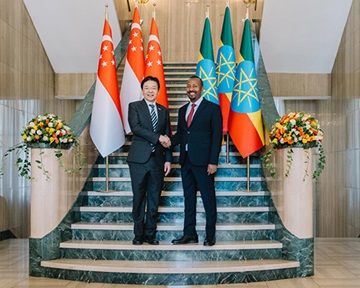Chinese-built steel plant heralds the return of manufacturing in Zimbabwe
The US$1bn facility is expected to start processing iron ore in 2024 and create 5000 jobs
By Amit Jain

China’s Tsingshan Group is building a world class iron and steel plant in the Zimbabwean district of Chirumhanzu. When complete it will produce 1.2m tonnes of steel a year and rake an annual turnover of US$1.5bn making Zimbabwe a key producer of steel in Southern Africa. The US$1bn project has been described as a showpiece of President Emmerson Mnangagwa’s business friendly economic policy and could very well put the country back on the world manufacturing map. From job creation to exports the project is likely to have a huge impact on both downstream and upstream industries. The plant sits on a 3 000-hectare piece of land. When complete it will boast a 1.5km x 600m carbon and steel plant, an iron ore mine and a ferrochrome plant. Apart from the physical infrastructure, the project will see major projects that cut across transport, housing, energy and water infrastructure. Its scope also entails a 50km railway line to link the site with the small mining town of Mvuma – 192km south of the capital Harare.
Tsingshan is also planning to construct a dam along Munyati River. The Chinese steel giant has already identified a site for dam construction and will need approvals from relevant authorities. The country’s mining development minister Winston Chitando believes the project will be a top foreign currency generator and a big contributor to the country’s US$12bn mining industry. Tsingshan has other investments in the country such as those in Selous and Hwange, where an energy park is being developed.
Zimbabwe once had a thriving iron and steel industry but years of economic mismanagement under former Robert Mugabe saw the slow but steady erosion of value-adding manufacturing sector. The hope now is that the Tsingshan plant could help once again kick start the industrialisation of Zimbabwe. Once complete the ultramodern steel complex will be capable of producing almost any desired type of steel. One such industry that is expected to benefit directly is the automobile assembly. Zimbabwe’s urban bus fleet is already being converted to electric. Local firms like Zupco are taking the lead. The advent of a steel industry producing a decent range of products, coupled with the existing industrial capacity to make cable and wind motors could allow a lot more local automobile component manufacture to take place. This is just one new industry that could be re-established quickly with moderate investments and could be expanded to trucks relatively simply.
Zimbabwe is widely believed to hold the second-largest reserves of chrome ore in the world (900m tonnes). The Tsingshan project is likely to feed into value addition. As such, Government has been pushing for mining companies to beneficiate minerals in order to enhance export earnings and boost job creation. Zimbabwe’s stable macro-economic environment and relatively modern infrastructure has helped attract the world’s top 500 firms to invest in various sectors of the economy. Its currency, which was once in a free fall, has stabilised. This has resulted in the return of investor confidence in the country.
References
‘New steel mills will allow heavy industry’, Business Weekly, 20 Dec 2021
‘Region's Biggest Steel Plant Roars to Life’, The Herald, 3 Aug 2021
‘Tsingshan deal shows the way’, The Sunday Mail, 15 Mar 2021
‘Manhize steel works a giant leap for Zim’, The Herald Zimbabwe, 4 August 2021
‘Major Chinese project on horizon’, The Sunday Mail, 31 May 2021








